Comprehensive Business Analysis of The Walt Disney Company
VerifiedAdded on 2022/06/07
|16
|4945
|28
Report
AI Summary
This report provides a comprehensive business analysis of The Walt Disney Company, covering its history from its humble beginnings as a cartoon studio to its current status as a global entertainment giant. It examines the company's mission and vision statements, key business segments like Disney Parks, Experiences and Products, Disney Media & Entertainment Distribution, and content groups. The report delves into Disney's strategies for reaching global markets, including foreign outsourcing, product sales, and licensing, as well as its approach to overcoming barriers to international trade such as sociocultural, economic, and political differences. A website analysis is also included, highlighting the company's use of online tracking, advertising, and social media. Finally, the report applies a PESTEL analysis to assess the political, economic, social, technological, environmental, and legal factors impacting Disney's business, such as intellectual property protection and shifting free trade policies. Overall, the report offers a detailed overview of Disney's operations, strategies, and challenges in the global entertainment industry.
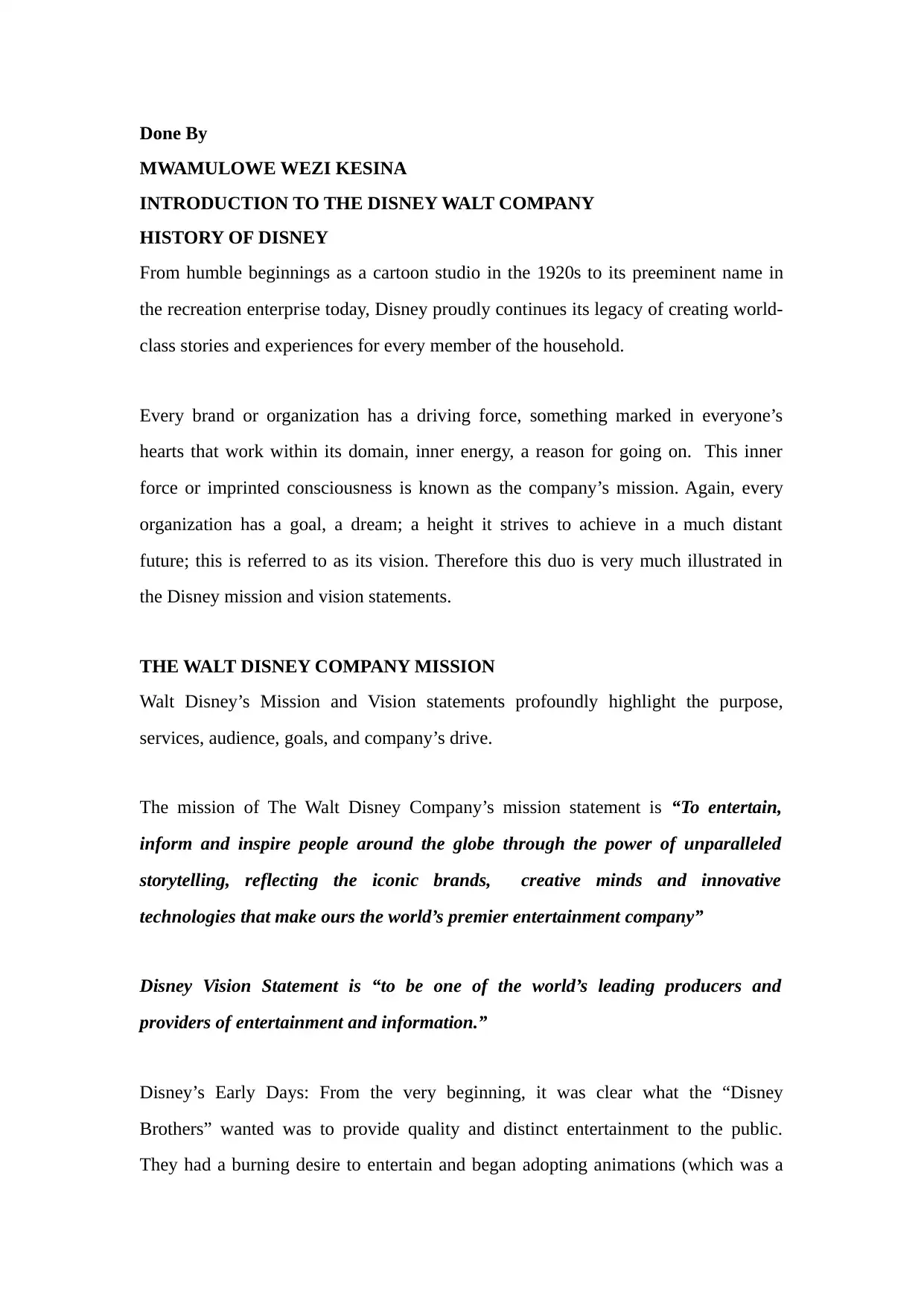
Done By
MWAMULOWE WEZI KESINA
INTRODUCTION TO THE DISNEY WALT COMPANY
HISTORY OF DISNEY
From humble beginnings as a cartoon studio in the 1920s to its preeminent name in
the recreation enterprise today, Disney proudly continues its legacy of creating world-
class stories and experiences for every member of the household.
Every brand or organization has a driving force, something marked in everyone’s
hearts that work within its domain, inner energy, a reason for going on. This inner
force or imprinted consciousness is known as the company’s mission. Again, every
organization has a goal, a dream; a height it strives to achieve in a much distant
future; this is referred to as its vision. Therefore this duo is very much illustrated in
the Disney mission and vision statements.
THE WALT DISNEY COMPANY MISSION
Walt Disney’s Mission and Vision statements profoundly highlight the purpose,
services, audience, goals, and company’s drive.
The mission of The Walt Disney Company’s mission statement is “To entertain,
inform and inspire people around the globe through the power of unparalleled
storytelling, reflecting the iconic brands, creative minds and innovative
technologies that make ours the world’s premier entertainment company”
Disney Vision Statement is “to be one of the world’s leading producers and
providers of entertainment and information.”
Disney’s Early Days: From the very beginning, it was clear what the “Disney
Brothers” wanted was to provide quality and distinct entertainment to the public.
They had a burning desire to entertain and began adopting animations (which was a
MWAMULOWE WEZI KESINA
INTRODUCTION TO THE DISNEY WALT COMPANY
HISTORY OF DISNEY
From humble beginnings as a cartoon studio in the 1920s to its preeminent name in
the recreation enterprise today, Disney proudly continues its legacy of creating world-
class stories and experiences for every member of the household.
Every brand or organization has a driving force, something marked in everyone’s
hearts that work within its domain, inner energy, a reason for going on. This inner
force or imprinted consciousness is known as the company’s mission. Again, every
organization has a goal, a dream; a height it strives to achieve in a much distant
future; this is referred to as its vision. Therefore this duo is very much illustrated in
the Disney mission and vision statements.
THE WALT DISNEY COMPANY MISSION
Walt Disney’s Mission and Vision statements profoundly highlight the purpose,
services, audience, goals, and company’s drive.
The mission of The Walt Disney Company’s mission statement is “To entertain,
inform and inspire people around the globe through the power of unparalleled
storytelling, reflecting the iconic brands, creative minds and innovative
technologies that make ours the world’s premier entertainment company”
Disney Vision Statement is “to be one of the world’s leading producers and
providers of entertainment and information.”
Disney’s Early Days: From the very beginning, it was clear what the “Disney
Brothers” wanted was to provide quality and distinct entertainment to the public.
They had a burning desire to entertain and began adopting animations (which was a
Paraphrase This Document
Need a fresh take? Get an instant paraphrase of this document with our AI Paraphraser
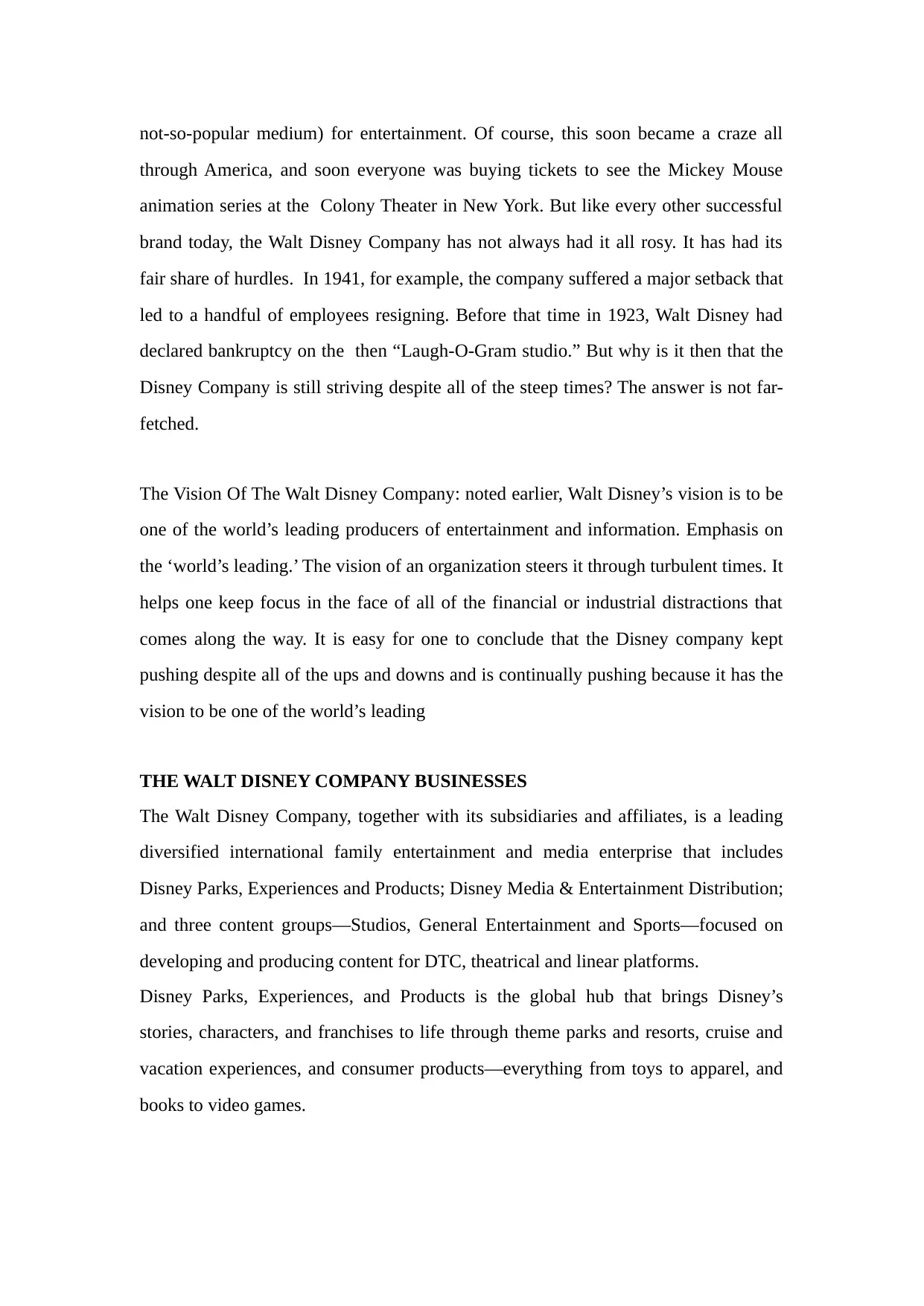
not-so-popular medium) for entertainment. Of course, this soon became a craze all
through America, and soon everyone was buying tickets to see the Mickey Mouse
animation series at the Colony Theater in New York. But like every other successful
brand today, the Walt Disney Company has not always had it all rosy. It has had its
fair share of hurdles. In 1941, for example, the company suffered a major setback that
led to a handful of employees resigning. Before that time in 1923, Walt Disney had
declared bankruptcy on the then “Laugh-O-Gram studio.” But why is it then that the
Disney Company is still striving despite all of the steep times? The answer is not far-
fetched.
The Vision Of The Walt Disney Company: noted earlier, Walt Disney’s vision is to be
one of the world’s leading producers of entertainment and information. Emphasis on
the ‘world’s leading.’ The vision of an organization steers it through turbulent times. It
helps one keep focus in the face of all of the financial or industrial distractions that
comes along the way. It is easy for one to conclude that the Disney company kept
pushing despite all of the ups and downs and is continually pushing because it has the
vision to be one of the world’s leading
THE WALT DISNEY COMPANY BUSINESSES
The Walt Disney Company, together with its subsidiaries and affiliates, is a leading
diversified international family entertainment and media enterprise that includes
Disney Parks, Experiences and Products; Disney Media & Entertainment Distribution;
and three content groups—Studios, General Entertainment and Sports—focused on
developing and producing content for DTC, theatrical and linear platforms.
Disney Parks, Experiences, and Products is the global hub that brings Disney’s
stories, characters, and franchises to life through theme parks and resorts, cruise and
vacation experiences, and consumer products—everything from toys to apparel, and
books to video games.
through America, and soon everyone was buying tickets to see the Mickey Mouse
animation series at the Colony Theater in New York. But like every other successful
brand today, the Walt Disney Company has not always had it all rosy. It has had its
fair share of hurdles. In 1941, for example, the company suffered a major setback that
led to a handful of employees resigning. Before that time in 1923, Walt Disney had
declared bankruptcy on the then “Laugh-O-Gram studio.” But why is it then that the
Disney Company is still striving despite all of the steep times? The answer is not far-
fetched.
The Vision Of The Walt Disney Company: noted earlier, Walt Disney’s vision is to be
one of the world’s leading producers of entertainment and information. Emphasis on
the ‘world’s leading.’ The vision of an organization steers it through turbulent times. It
helps one keep focus in the face of all of the financial or industrial distractions that
comes along the way. It is easy for one to conclude that the Disney company kept
pushing despite all of the ups and downs and is continually pushing because it has the
vision to be one of the world’s leading
THE WALT DISNEY COMPANY BUSINESSES
The Walt Disney Company, together with its subsidiaries and affiliates, is a leading
diversified international family entertainment and media enterprise that includes
Disney Parks, Experiences and Products; Disney Media & Entertainment Distribution;
and three content groups—Studios, General Entertainment and Sports—focused on
developing and producing content for DTC, theatrical and linear platforms.
Disney Parks, Experiences, and Products is the global hub that brings Disney’s
stories, characters, and franchises to life through theme parks and resorts, cruise and
vacation experiences, and consumer products—everything from toys to apparel, and
books to video games.
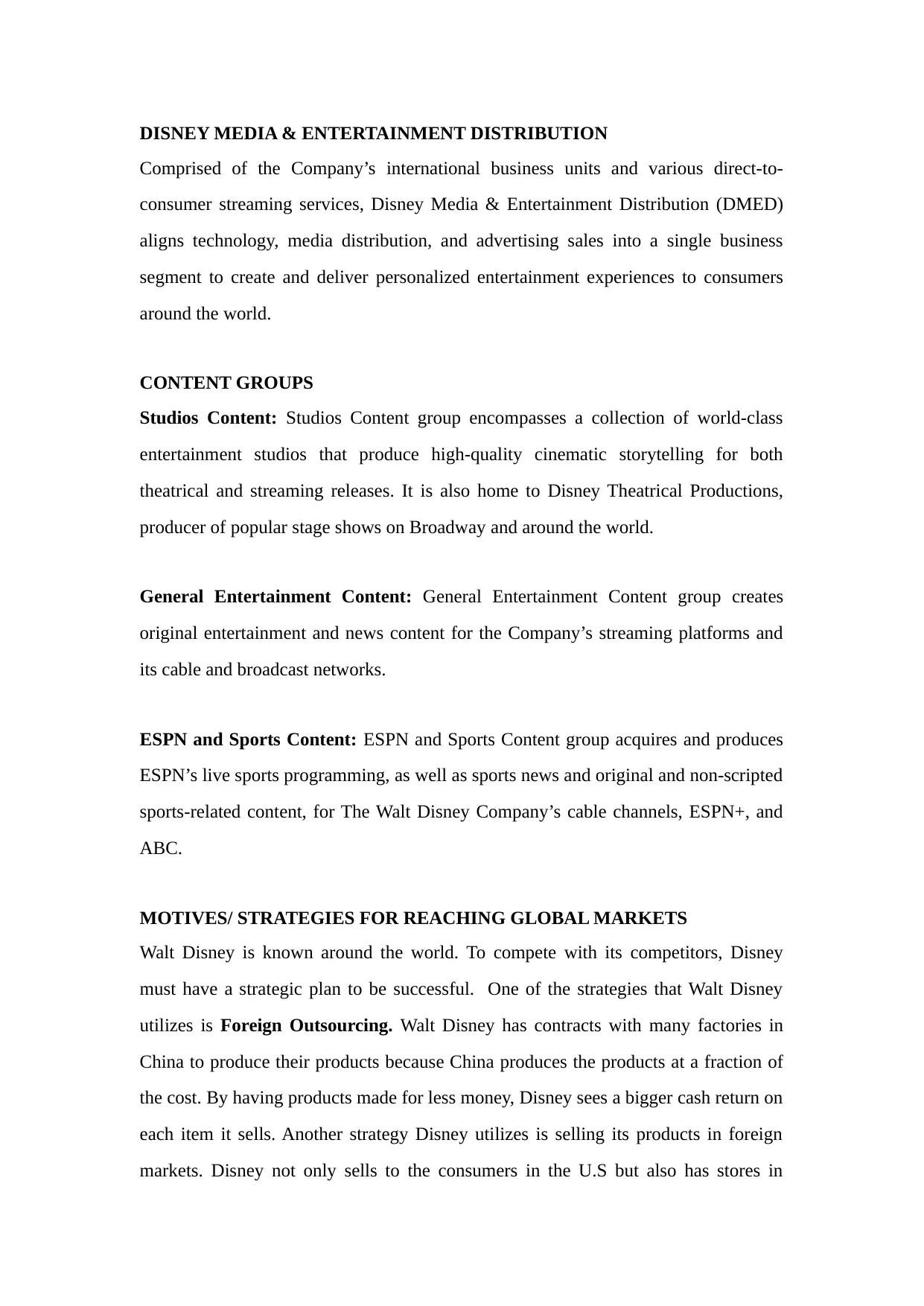
DISNEY MEDIA & ENTERTAINMENT DISTRIBUTION
Comprised of the Company’s international business units and various direct-to-
consumer streaming services, Disney Media & Entertainment Distribution (DMED)
aligns technology, media distribution, and advertising sales into a single business
segment to create and deliver personalized entertainment experiences to consumers
around the world.
CONTENT GROUPS
Studios Content: Studios Content group encompasses a collection of world-class
entertainment studios that produce high-quality cinematic storytelling for both
theatrical and streaming releases. It is also home to Disney Theatrical Productions,
producer of popular stage shows on Broadway and around the world.
General Entertainment Content: General Entertainment Content group creates
original entertainment and news content for the Company’s streaming platforms and
its cable and broadcast networks.
ESPN and Sports Content: ESPN and Sports Content group acquires and produces
ESPN’s live sports programming, as well as sports news and original and non-scripted
sports-related content, for The Walt Disney Company’s cable channels, ESPN+, and
ABC.
MOTIVES/ STRATEGIES FOR REACHING GLOBAL MARKETS
Walt Disney is known around the world. To compete with its competitors, Disney
must have a strategic plan to be successful. One of the strategies that Walt Disney
utilizes is Foreign Outsourcing. Walt Disney has contracts with many factories in
China to produce their products because China produces the products at a fraction of
the cost. By having products made for less money, Disney sees a bigger cash return on
each item it sells. Another strategy Disney utilizes is selling its products in foreign
markets. Disney not only sells to the consumers in the U.S but also has stores in
Comprised of the Company’s international business units and various direct-to-
consumer streaming services, Disney Media & Entertainment Distribution (DMED)
aligns technology, media distribution, and advertising sales into a single business
segment to create and deliver personalized entertainment experiences to consumers
around the world.
CONTENT GROUPS
Studios Content: Studios Content group encompasses a collection of world-class
entertainment studios that produce high-quality cinematic storytelling for both
theatrical and streaming releases. It is also home to Disney Theatrical Productions,
producer of popular stage shows on Broadway and around the world.
General Entertainment Content: General Entertainment Content group creates
original entertainment and news content for the Company’s streaming platforms and
its cable and broadcast networks.
ESPN and Sports Content: ESPN and Sports Content group acquires and produces
ESPN’s live sports programming, as well as sports news and original and non-scripted
sports-related content, for The Walt Disney Company’s cable channels, ESPN+, and
ABC.
MOTIVES/ STRATEGIES FOR REACHING GLOBAL MARKETS
Walt Disney is known around the world. To compete with its competitors, Disney
must have a strategic plan to be successful. One of the strategies that Walt Disney
utilizes is Foreign Outsourcing. Walt Disney has contracts with many factories in
China to produce their products because China produces the products at a fraction of
the cost. By having products made for less money, Disney sees a bigger cash return on
each item it sells. Another strategy Disney utilizes is selling its products in foreign
markets. Disney not only sells to the consumers in the U.S but also has stores in
⊘ This is a preview!⊘
Do you want full access?
Subscribe today to unlock all pages.

Trusted by 1+ million students worldwide
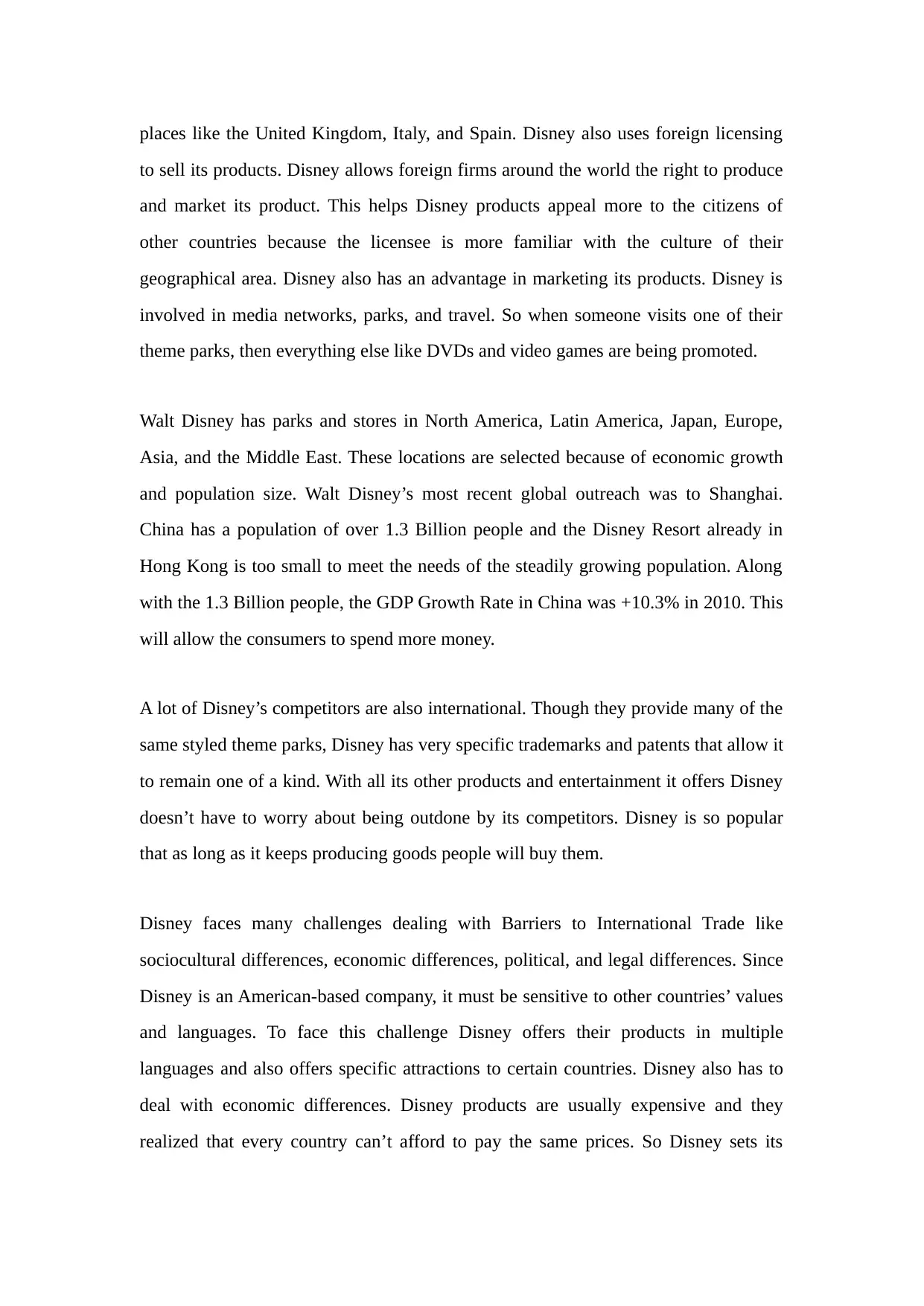
places like the United Kingdom, Italy, and Spain. Disney also uses foreign licensing
to sell its products. Disney allows foreign firms around the world the right to produce
and market its product. This helps Disney products appeal more to the citizens of
other countries because the licensee is more familiar with the culture of their
geographical area. Disney also has an advantage in marketing its products. Disney is
involved in media networks, parks, and travel. So when someone visits one of their
theme parks, then everything else like DVDs and video games are being promoted.
Walt Disney has parks and stores in North America, Latin America, Japan, Europe,
Asia, and the Middle East. These locations are selected because of economic growth
and population size. Walt Disney’s most recent global outreach was to Shanghai.
China has a population of over 1.3 Billion people and the Disney Resort already in
Hong Kong is too small to meet the needs of the steadily growing population. Along
with the 1.3 Billion people, the GDP Growth Rate in China was +10.3% in 2010. This
will allow the consumers to spend more money.
A lot of Disney’s competitors are also international. Though they provide many of the
same styled theme parks, Disney has very specific trademarks and patents that allow it
to remain one of a kind. With all its other products and entertainment it offers Disney
doesn’t have to worry about being outdone by its competitors. Disney is so popular
that as long as it keeps producing goods people will buy them.
Disney faces many challenges dealing with Barriers to International Trade like
sociocultural differences, economic differences, political, and legal differences. Since
Disney is an American-based company, it must be sensitive to other countries’ values
and languages. To face this challenge Disney offers their products in multiple
languages and also offers specific attractions to certain countries. Disney also has to
deal with economic differences. Disney products are usually expensive and they
realized that every country can’t afford to pay the same prices. So Disney sets its
to sell its products. Disney allows foreign firms around the world the right to produce
and market its product. This helps Disney products appeal more to the citizens of
other countries because the licensee is more familiar with the culture of their
geographical area. Disney also has an advantage in marketing its products. Disney is
involved in media networks, parks, and travel. So when someone visits one of their
theme parks, then everything else like DVDs and video games are being promoted.
Walt Disney has parks and stores in North America, Latin America, Japan, Europe,
Asia, and the Middle East. These locations are selected because of economic growth
and population size. Walt Disney’s most recent global outreach was to Shanghai.
China has a population of over 1.3 Billion people and the Disney Resort already in
Hong Kong is too small to meet the needs of the steadily growing population. Along
with the 1.3 Billion people, the GDP Growth Rate in China was +10.3% in 2010. This
will allow the consumers to spend more money.
A lot of Disney’s competitors are also international. Though they provide many of the
same styled theme parks, Disney has very specific trademarks and patents that allow it
to remain one of a kind. With all its other products and entertainment it offers Disney
doesn’t have to worry about being outdone by its competitors. Disney is so popular
that as long as it keeps producing goods people will buy them.
Disney faces many challenges dealing with Barriers to International Trade like
sociocultural differences, economic differences, political, and legal differences. Since
Disney is an American-based company, it must be sensitive to other countries’ values
and languages. To face this challenge Disney offers their products in multiple
languages and also offers specific attractions to certain countries. Disney also has to
deal with economic differences. Disney products are usually expensive and they
realized that every country can’t afford to pay the same prices. So Disney sets its
Paraphrase This Document
Need a fresh take? Get an instant paraphrase of this document with our AI Paraphraser
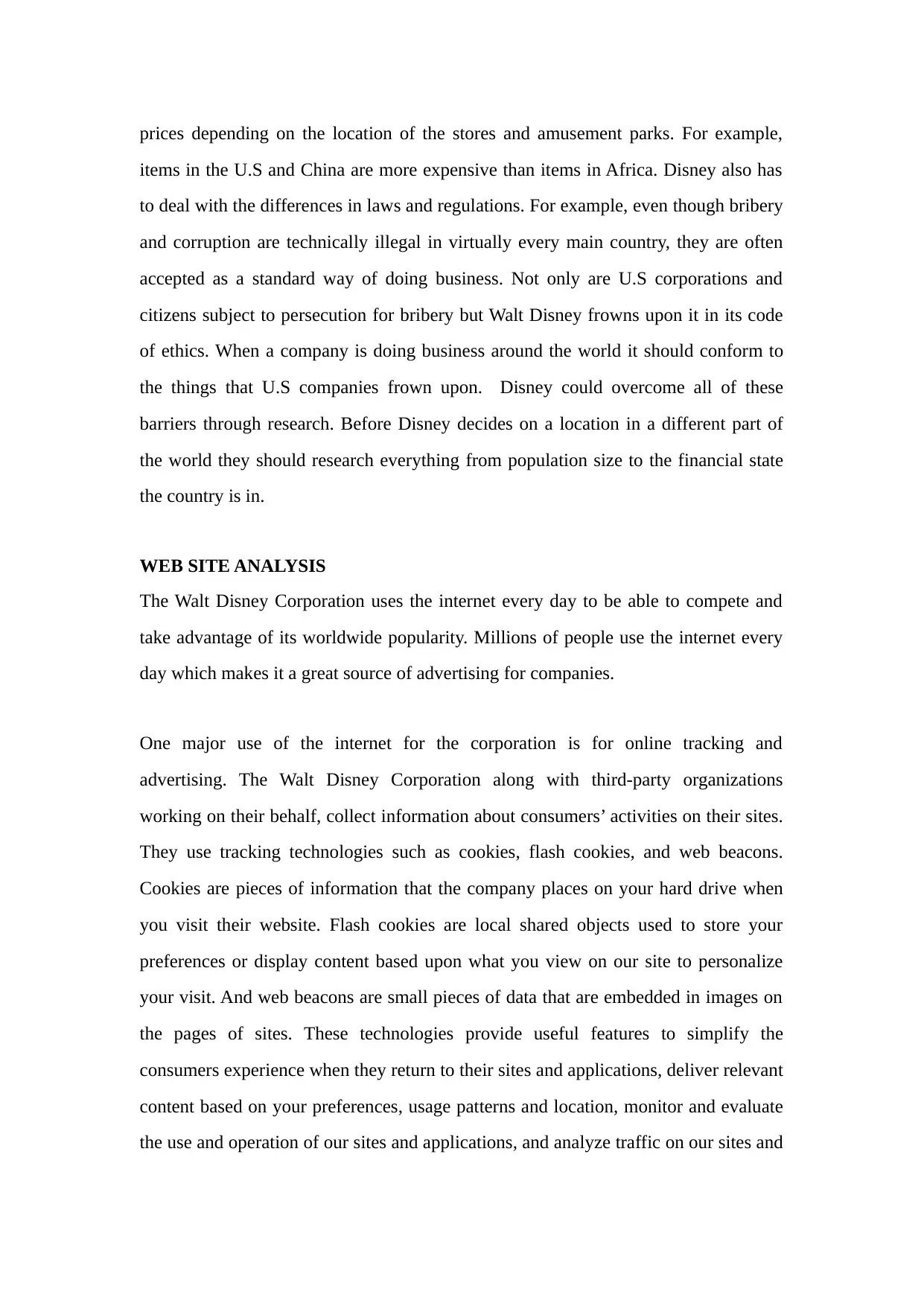
prices depending on the location of the stores and amusement parks. For example,
items in the U.S and China are more expensive than items in Africa. Disney also has
to deal with the differences in laws and regulations. For example, even though bribery
and corruption are technically illegal in virtually every main country, they are often
accepted as a standard way of doing business. Not only are U.S corporations and
citizens subject to persecution for bribery but Walt Disney frowns upon it in its code
of ethics. When a company is doing business around the world it should conform to
the things that U.S companies frown upon. Disney could overcome all of these
barriers through research. Before Disney decides on a location in a different part of
the world they should research everything from population size to the financial state
the country is in.
WEB SITE ANALYSIS
The Walt Disney Corporation uses the internet every day to be able to compete and
take advantage of its worldwide popularity. Millions of people use the internet every
day which makes it a great source of advertising for companies.
One major use of the internet for the corporation is for online tracking and
advertising. The Walt Disney Corporation along with third-party organizations
working on their behalf, collect information about consumers’ activities on their sites.
They use tracking technologies such as cookies, flash cookies, and web beacons.
Cookies are pieces of information that the company places on your hard drive when
you visit their website. Flash cookies are local shared objects used to store your
preferences or display content based upon what you view on our site to personalize
your visit. And web beacons are small pieces of data that are embedded in images on
the pages of sites. These technologies provide useful features to simplify the
consumers experience when they return to their sites and applications, deliver relevant
content based on your preferences, usage patterns and location, monitor and evaluate
the use and operation of our sites and applications, and analyze traffic on our sites and
items in the U.S and China are more expensive than items in Africa. Disney also has
to deal with the differences in laws and regulations. For example, even though bribery
and corruption are technically illegal in virtually every main country, they are often
accepted as a standard way of doing business. Not only are U.S corporations and
citizens subject to persecution for bribery but Walt Disney frowns upon it in its code
of ethics. When a company is doing business around the world it should conform to
the things that U.S companies frown upon. Disney could overcome all of these
barriers through research. Before Disney decides on a location in a different part of
the world they should research everything from population size to the financial state
the country is in.
WEB SITE ANALYSIS
The Walt Disney Corporation uses the internet every day to be able to compete and
take advantage of its worldwide popularity. Millions of people use the internet every
day which makes it a great source of advertising for companies.
One major use of the internet for the corporation is for online tracking and
advertising. The Walt Disney Corporation along with third-party organizations
working on their behalf, collect information about consumers’ activities on their sites.
They use tracking technologies such as cookies, flash cookies, and web beacons.
Cookies are pieces of information that the company places on your hard drive when
you visit their website. Flash cookies are local shared objects used to store your
preferences or display content based upon what you view on our site to personalize
your visit. And web beacons are small pieces of data that are embedded in images on
the pages of sites. These technologies provide useful features to simplify the
consumers experience when they return to their sites and applications, deliver relevant
content based on your preferences, usage patterns and location, monitor and evaluate
the use and operation of our sites and applications, and analyze traffic on our sites and
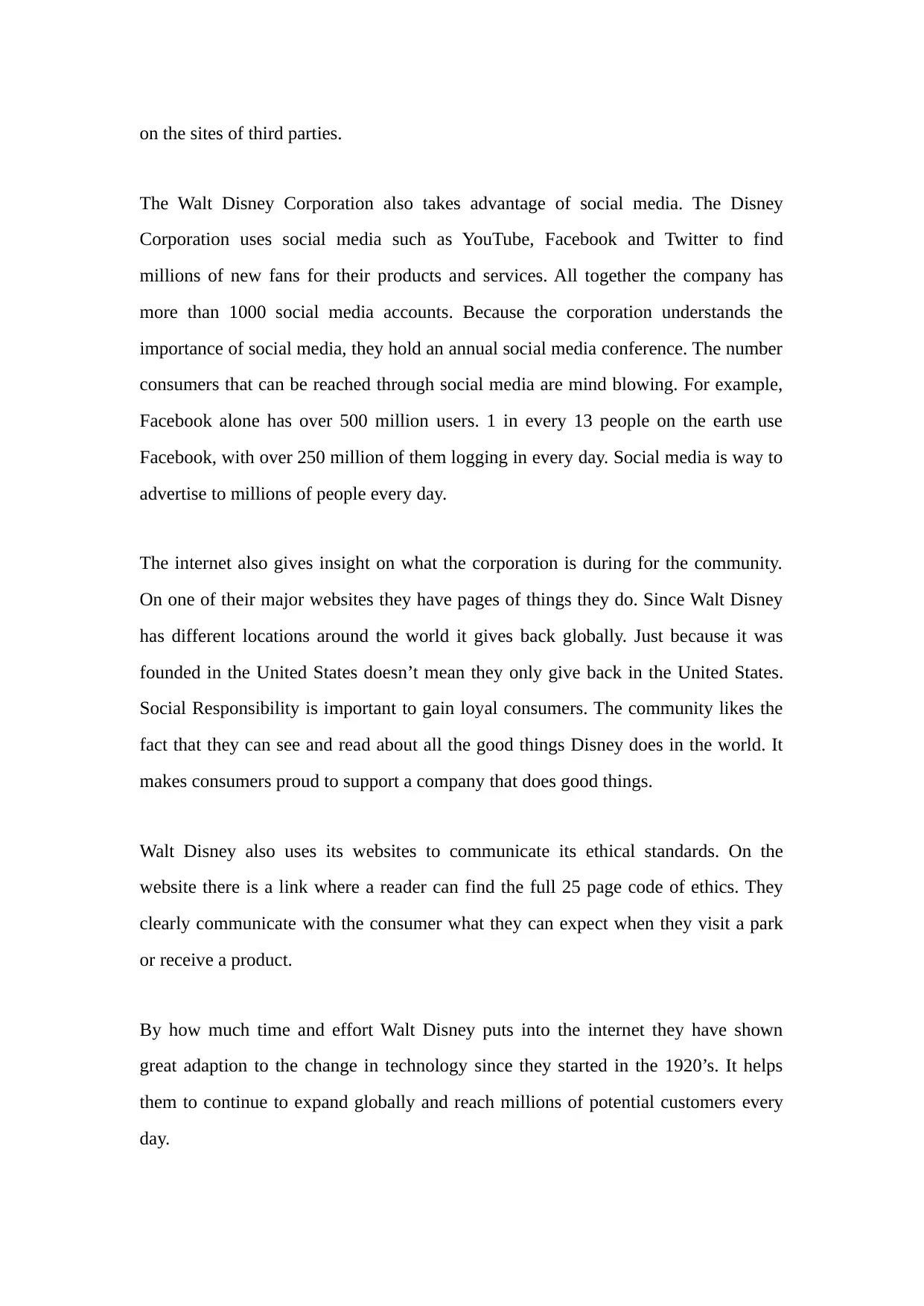
on the sites of third parties.
The Walt Disney Corporation also takes advantage of social media. The Disney
Corporation uses social media such as YouTube, Facebook and Twitter to find
millions of new fans for their products and services. All together the company has
more than 1000 social media accounts. Because the corporation understands the
importance of social media, they hold an annual social media conference. The number
consumers that can be reached through social media are mind blowing. For example,
Facebook alone has over 500 million users. 1 in every 13 people on the earth use
Facebook, with over 250 million of them logging in every day. Social media is way to
advertise to millions of people every day.
The internet also gives insight on what the corporation is during for the community.
On one of their major websites they have pages of things they do. Since Walt Disney
has different locations around the world it gives back globally. Just because it was
founded in the United States doesn’t mean they only give back in the United States.
Social Responsibility is important to gain loyal consumers. The community likes the
fact that they can see and read about all the good things Disney does in the world. It
makes consumers proud to support a company that does good things.
Walt Disney also uses its websites to communicate its ethical standards. On the
website there is a link where a reader can find the full 25 page code of ethics. They
clearly communicate with the consumer what they can expect when they visit a park
or receive a product.
By how much time and effort Walt Disney puts into the internet they have shown
great adaption to the change in technology since they started in the 1920’s. It helps
them to continue to expand globally and reach millions of potential customers every
day.
The Walt Disney Corporation also takes advantage of social media. The Disney
Corporation uses social media such as YouTube, Facebook and Twitter to find
millions of new fans for their products and services. All together the company has
more than 1000 social media accounts. Because the corporation understands the
importance of social media, they hold an annual social media conference. The number
consumers that can be reached through social media are mind blowing. For example,
Facebook alone has over 500 million users. 1 in every 13 people on the earth use
Facebook, with over 250 million of them logging in every day. Social media is way to
advertise to millions of people every day.
The internet also gives insight on what the corporation is during for the community.
On one of their major websites they have pages of things they do. Since Walt Disney
has different locations around the world it gives back globally. Just because it was
founded in the United States doesn’t mean they only give back in the United States.
Social Responsibility is important to gain loyal consumers. The community likes the
fact that they can see and read about all the good things Disney does in the world. It
makes consumers proud to support a company that does good things.
Walt Disney also uses its websites to communicate its ethical standards. On the
website there is a link where a reader can find the full 25 page code of ethics. They
clearly communicate with the consumer what they can expect when they visit a park
or receive a product.
By how much time and effort Walt Disney puts into the internet they have shown
great adaption to the change in technology since they started in the 1920’s. It helps
them to continue to expand globally and reach millions of potential customers every
day.
⊘ This is a preview!⊘
Do you want full access?
Subscribe today to unlock all pages.

Trusted by 1+ million students worldwide
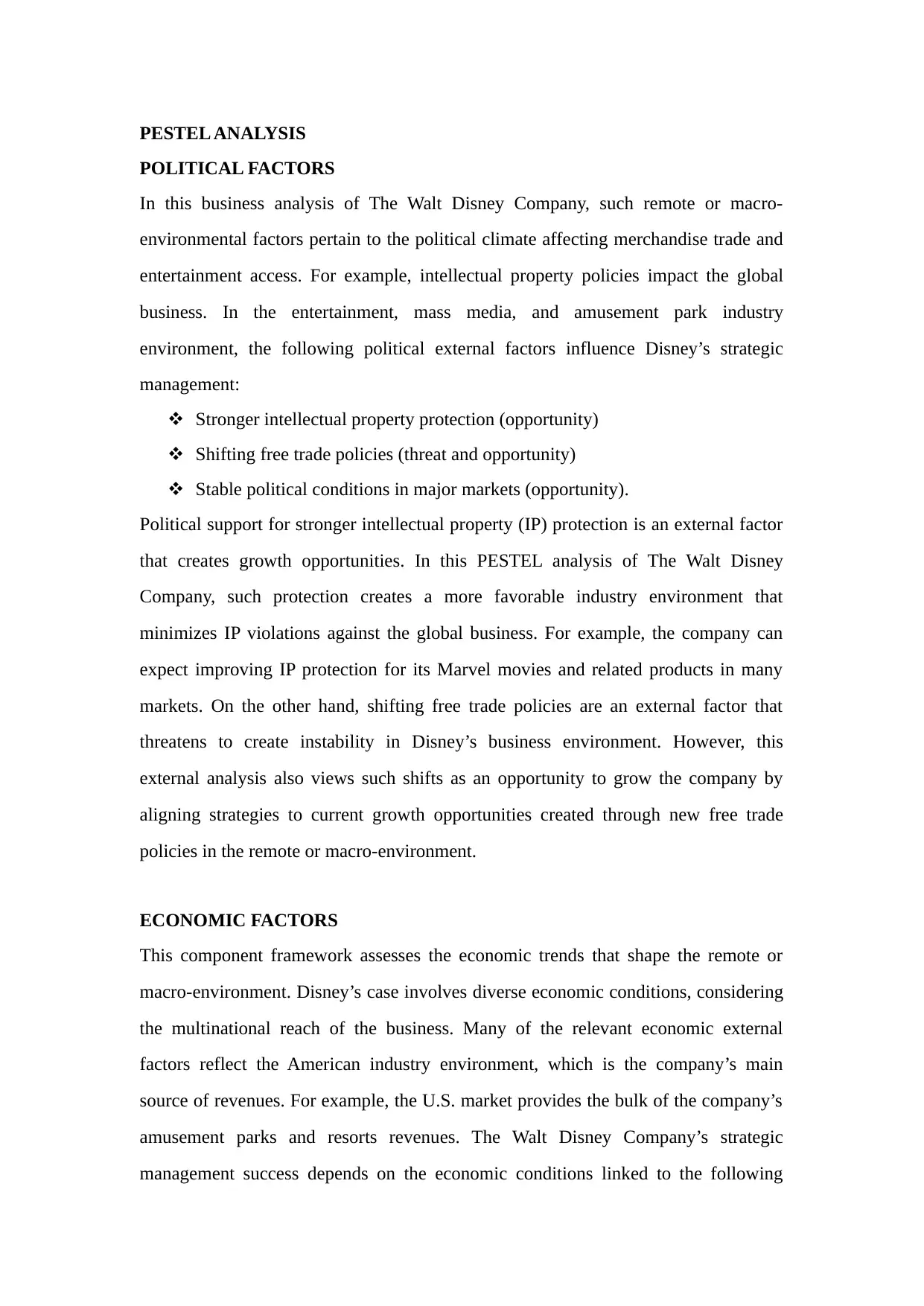
PESTEL ANALYSIS
POLITICAL FACTORS
In this business analysis of The Walt Disney Company, such remote or macro-
environmental factors pertain to the political climate affecting merchandise trade and
entertainment access. For example, intellectual property policies impact the global
business. In the entertainment, mass media, and amusement park industry
environment, the following political external factors influence Disney’s strategic
management:
Stronger intellectual property protection (opportunity)
Shifting free trade policies (threat and opportunity)
Stable political conditions in major markets (opportunity).
Political support for stronger intellectual property (IP) protection is an external factor
that creates growth opportunities. In this PESTEL analysis of The Walt Disney
Company, such protection creates a more favorable industry environment that
minimizes IP violations against the global business. For example, the company can
expect improving IP protection for its Marvel movies and related products in many
markets. On the other hand, shifting free trade policies are an external factor that
threatens to create instability in Disney’s business environment. However, this
external analysis also views such shifts as an opportunity to grow the company by
aligning strategies to current growth opportunities created through new free trade
policies in the remote or macro-environment.
ECONOMIC FACTORS
This component framework assesses the economic trends that shape the remote or
macro-environment. Disney’s case involves diverse economic conditions, considering
the multinational reach of the business. Many of the relevant economic external
factors reflect the American industry environment, which is the company’s main
source of revenues. For example, the U.S. market provides the bulk of the company’s
amusement parks and resorts revenues. The Walt Disney Company’s strategic
management success depends on the economic conditions linked to the following
POLITICAL FACTORS
In this business analysis of The Walt Disney Company, such remote or macro-
environmental factors pertain to the political climate affecting merchandise trade and
entertainment access. For example, intellectual property policies impact the global
business. In the entertainment, mass media, and amusement park industry
environment, the following political external factors influence Disney’s strategic
management:
Stronger intellectual property protection (opportunity)
Shifting free trade policies (threat and opportunity)
Stable political conditions in major markets (opportunity).
Political support for stronger intellectual property (IP) protection is an external factor
that creates growth opportunities. In this PESTEL analysis of The Walt Disney
Company, such protection creates a more favorable industry environment that
minimizes IP violations against the global business. For example, the company can
expect improving IP protection for its Marvel movies and related products in many
markets. On the other hand, shifting free trade policies are an external factor that
threatens to create instability in Disney’s business environment. However, this
external analysis also views such shifts as an opportunity to grow the company by
aligning strategies to current growth opportunities created through new free trade
policies in the remote or macro-environment.
ECONOMIC FACTORS
This component framework assesses the economic trends that shape the remote or
macro-environment. Disney’s case involves diverse economic conditions, considering
the multinational reach of the business. Many of the relevant economic external
factors reflect the American industry environment, which is the company’s main
source of revenues. For example, the U.S. market provides the bulk of the company’s
amusement parks and resorts revenues. The Walt Disney Company’s strategic
management success depends on the economic conditions linked to the following
Paraphrase This Document
Need a fresh take? Get an instant paraphrase of this document with our AI Paraphraser
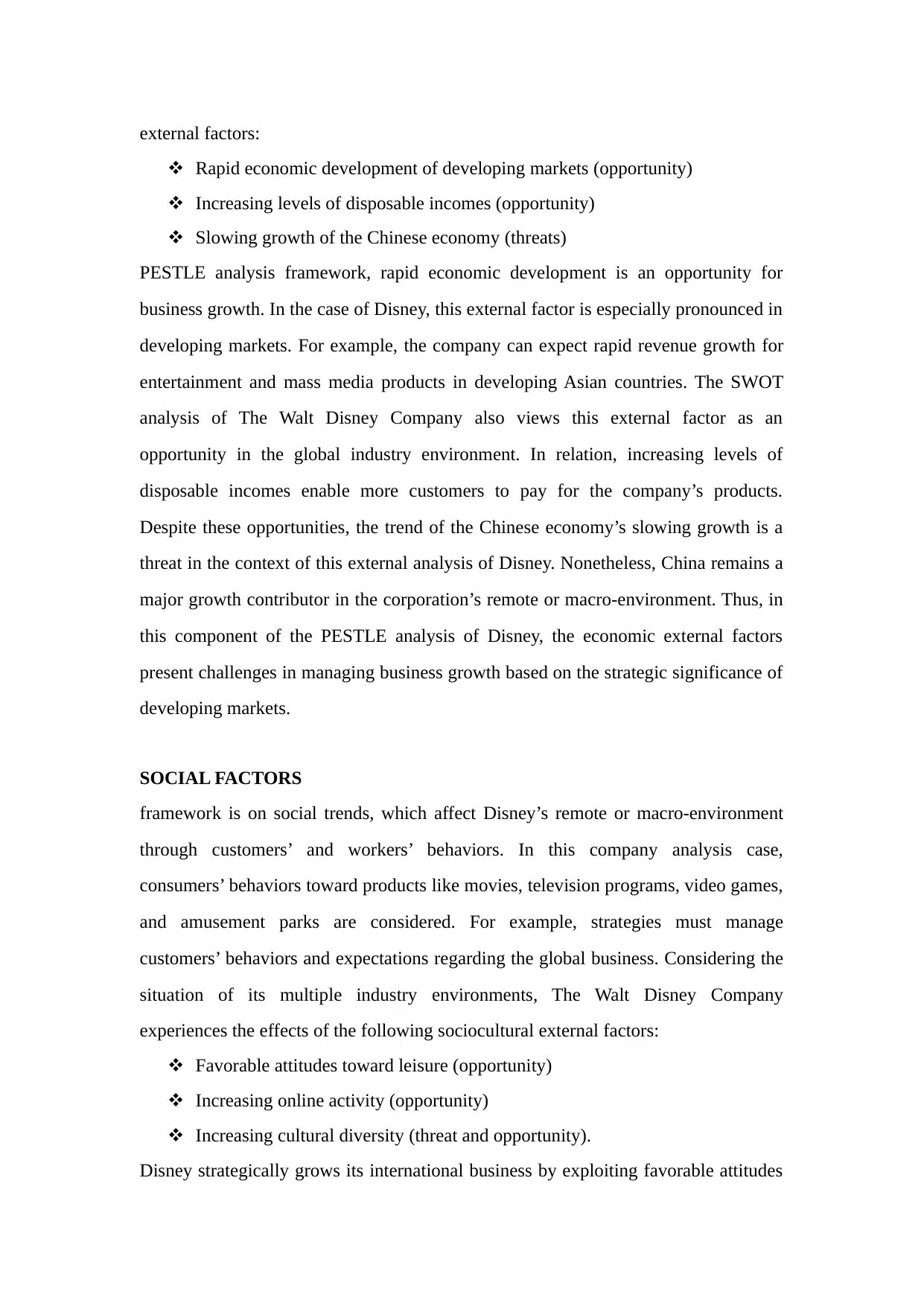
external factors:
Rapid economic development of developing markets (opportunity)
Increasing levels of disposable incomes (opportunity)
Slowing growth of the Chinese economy (threats)
PESTLE analysis framework, rapid economic development is an opportunity for
business growth. In the case of Disney, this external factor is especially pronounced in
developing markets. For example, the company can expect rapid revenue growth for
entertainment and mass media products in developing Asian countries. The SWOT
analysis of The Walt Disney Company also views this external factor as an
opportunity in the global industry environment. In relation, increasing levels of
disposable incomes enable more customers to pay for the company’s products.
Despite these opportunities, the trend of the Chinese economy’s slowing growth is a
threat in the context of this external analysis of Disney. Nonetheless, China remains a
major growth contributor in the corporation’s remote or macro-environment. Thus, in
this component of the PESTLE analysis of Disney, the economic external factors
present challenges in managing business growth based on the strategic significance of
developing markets.
SOCIAL FACTORS
framework is on social trends, which affect Disney’s remote or macro-environment
through customers’ and workers’ behaviors. In this company analysis case,
consumers’ behaviors toward products like movies, television programs, video games,
and amusement parks are considered. For example, strategies must manage
customers’ behaviors and expectations regarding the global business. Considering the
situation of its multiple industry environments, The Walt Disney Company
experiences the effects of the following sociocultural external factors:
Favorable attitudes toward leisure (opportunity)
Increasing online activity (opportunity)
Increasing cultural diversity (threat and opportunity).
Disney strategically grows its international business by exploiting favorable attitudes
Rapid economic development of developing markets (opportunity)
Increasing levels of disposable incomes (opportunity)
Slowing growth of the Chinese economy (threats)
PESTLE analysis framework, rapid economic development is an opportunity for
business growth. In the case of Disney, this external factor is especially pronounced in
developing markets. For example, the company can expect rapid revenue growth for
entertainment and mass media products in developing Asian countries. The SWOT
analysis of The Walt Disney Company also views this external factor as an
opportunity in the global industry environment. In relation, increasing levels of
disposable incomes enable more customers to pay for the company’s products.
Despite these opportunities, the trend of the Chinese economy’s slowing growth is a
threat in the context of this external analysis of Disney. Nonetheless, China remains a
major growth contributor in the corporation’s remote or macro-environment. Thus, in
this component of the PESTLE analysis of Disney, the economic external factors
present challenges in managing business growth based on the strategic significance of
developing markets.
SOCIAL FACTORS
framework is on social trends, which affect Disney’s remote or macro-environment
through customers’ and workers’ behaviors. In this company analysis case,
consumers’ behaviors toward products like movies, television programs, video games,
and amusement parks are considered. For example, strategies must manage
customers’ behaviors and expectations regarding the global business. Considering the
situation of its multiple industry environments, The Walt Disney Company
experiences the effects of the following sociocultural external factors:
Favorable attitudes toward leisure (opportunity)
Increasing online activity (opportunity)
Increasing cultural diversity (threat and opportunity).
Disney strategically grows its international business by exploiting favorable attitudes
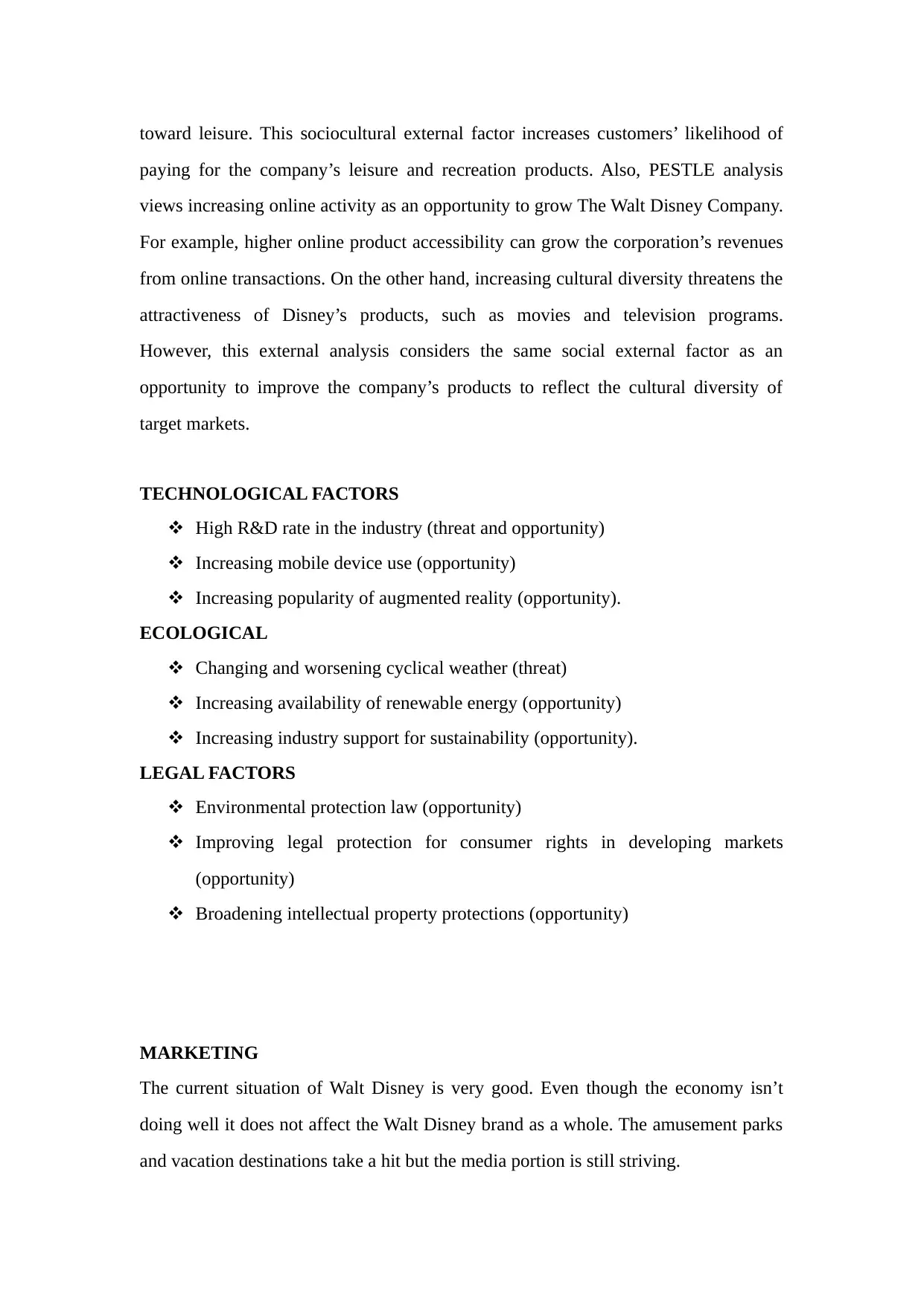
toward leisure. This sociocultural external factor increases customers’ likelihood of
paying for the company’s leisure and recreation products. Also, PESTLE analysis
views increasing online activity as an opportunity to grow The Walt Disney Company.
For example, higher online product accessibility can grow the corporation’s revenues
from online transactions. On the other hand, increasing cultural diversity threatens the
attractiveness of Disney’s products, such as movies and television programs.
However, this external analysis considers the same social external factor as an
opportunity to improve the company’s products to reflect the cultural diversity of
target markets.
TECHNOLOGICAL FACTORS
High R&D rate in the industry (threat and opportunity)
Increasing mobile device use (opportunity)
Increasing popularity of augmented reality (opportunity).
ECOLOGICAL
Changing and worsening cyclical weather (threat)
Increasing availability of renewable energy (opportunity)
Increasing industry support for sustainability (opportunity).
LEGAL FACTORS
Environmental protection law (opportunity)
Improving legal protection for consumer rights in developing markets
(opportunity)
Broadening intellectual property protections (opportunity)
MARKETING
The current situation of Walt Disney is very good. Even though the economy isn’t
doing well it does not affect the Walt Disney brand as a whole. The amusement parks
and vacation destinations take a hit but the media portion is still striving.
paying for the company’s leisure and recreation products. Also, PESTLE analysis
views increasing online activity as an opportunity to grow The Walt Disney Company.
For example, higher online product accessibility can grow the corporation’s revenues
from online transactions. On the other hand, increasing cultural diversity threatens the
attractiveness of Disney’s products, such as movies and television programs.
However, this external analysis considers the same social external factor as an
opportunity to improve the company’s products to reflect the cultural diversity of
target markets.
TECHNOLOGICAL FACTORS
High R&D rate in the industry (threat and opportunity)
Increasing mobile device use (opportunity)
Increasing popularity of augmented reality (opportunity).
ECOLOGICAL
Changing and worsening cyclical weather (threat)
Increasing availability of renewable energy (opportunity)
Increasing industry support for sustainability (opportunity).
LEGAL FACTORS
Environmental protection law (opportunity)
Improving legal protection for consumer rights in developing markets
(opportunity)
Broadening intellectual property protections (opportunity)
MARKETING
The current situation of Walt Disney is very good. Even though the economy isn’t
doing well it does not affect the Walt Disney brand as a whole. The amusement parks
and vacation destinations take a hit but the media portion is still striving.
⊘ This is a preview!⊘
Do you want full access?
Subscribe today to unlock all pages.

Trusted by 1+ million students worldwide
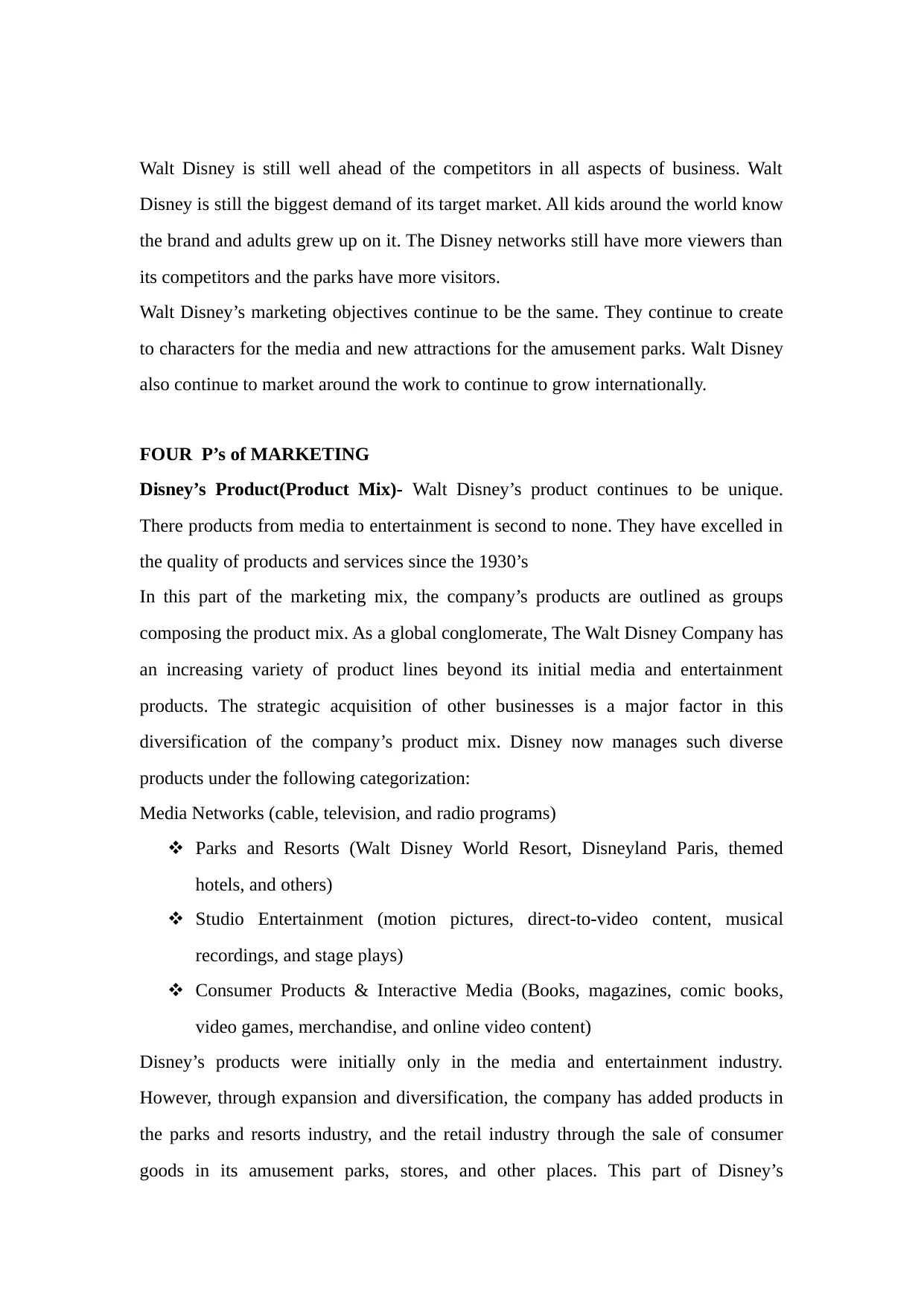
Walt Disney is still well ahead of the competitors in all aspects of business. Walt
Disney is still the biggest demand of its target market. All kids around the world know
the brand and adults grew up on it. The Disney networks still have more viewers than
its competitors and the parks have more visitors.
Walt Disney’s marketing objectives continue to be the same. They continue to create
to characters for the media and new attractions for the amusement parks. Walt Disney
also continue to market around the work to continue to grow internationally.
FOUR P’s of MARKETING
Disney’s Product(Product Mix)- Walt Disney’s product continues to be unique.
There products from media to entertainment is second to none. They have excelled in
the quality of products and services since the 1930’s
In this part of the marketing mix, the company’s products are outlined as groups
composing the product mix. As a global conglomerate, The Walt Disney Company has
an increasing variety of product lines beyond its initial media and entertainment
products. The strategic acquisition of other businesses is a major factor in this
diversification of the company’s product mix. Disney now manages such diverse
products under the following categorization:
Media Networks (cable, television, and radio programs)
Parks and Resorts (Walt Disney World Resort, Disneyland Paris, themed
hotels, and others)
Studio Entertainment (motion pictures, direct-to-video content, musical
recordings, and stage plays)
Consumer Products & Interactive Media (Books, magazines, comic books,
video games, merchandise, and online video content)
Disney’s products were initially only in the media and entertainment industry.
However, through expansion and diversification, the company has added products in
the parks and resorts industry, and the retail industry through the sale of consumer
goods in its amusement parks, stores, and other places. This part of Disney’s
Disney is still the biggest demand of its target market. All kids around the world know
the brand and adults grew up on it. The Disney networks still have more viewers than
its competitors and the parks have more visitors.
Walt Disney’s marketing objectives continue to be the same. They continue to create
to characters for the media and new attractions for the amusement parks. Walt Disney
also continue to market around the work to continue to grow internationally.
FOUR P’s of MARKETING
Disney’s Product(Product Mix)- Walt Disney’s product continues to be unique.
There products from media to entertainment is second to none. They have excelled in
the quality of products and services since the 1930’s
In this part of the marketing mix, the company’s products are outlined as groups
composing the product mix. As a global conglomerate, The Walt Disney Company has
an increasing variety of product lines beyond its initial media and entertainment
products. The strategic acquisition of other businesses is a major factor in this
diversification of the company’s product mix. Disney now manages such diverse
products under the following categorization:
Media Networks (cable, television, and radio programs)
Parks and Resorts (Walt Disney World Resort, Disneyland Paris, themed
hotels, and others)
Studio Entertainment (motion pictures, direct-to-video content, musical
recordings, and stage plays)
Consumer Products & Interactive Media (Books, magazines, comic books,
video games, merchandise, and online video content)
Disney’s products were initially only in the media and entertainment industry.
However, through expansion and diversification, the company has added products in
the parks and resorts industry, and the retail industry through the sale of consumer
goods in its amusement parks, stores, and other places. This part of Disney’s
Paraphrase This Document
Need a fresh take? Get an instant paraphrase of this document with our AI Paraphraser
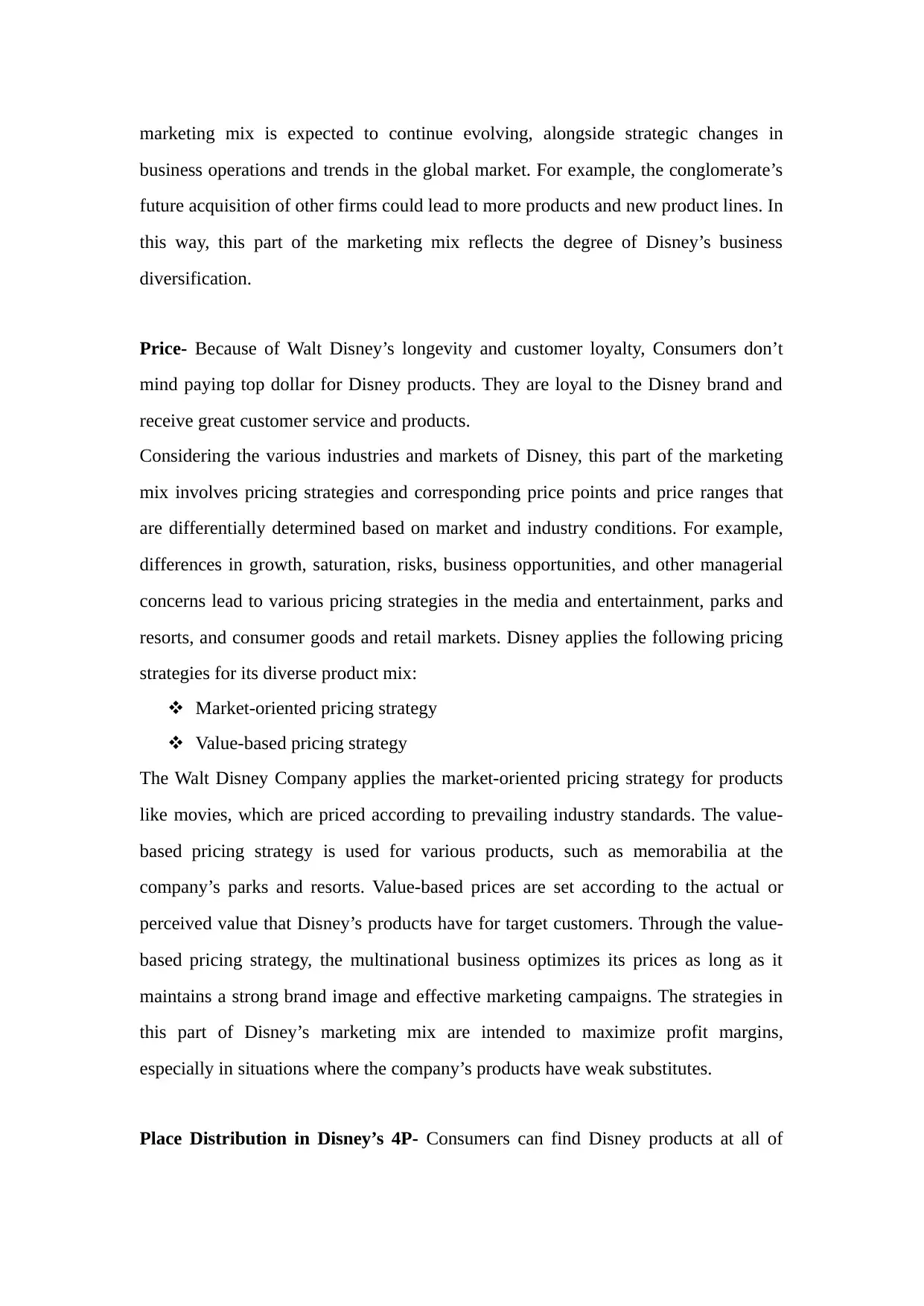
marketing mix is expected to continue evolving, alongside strategic changes in
business operations and trends in the global market. For example, the conglomerate’s
future acquisition of other firms could lead to more products and new product lines. In
this way, this part of the marketing mix reflects the degree of Disney’s business
diversification.
Price- Because of Walt Disney’s longevity and customer loyalty, Consumers don’t
mind paying top dollar for Disney products. They are loyal to the Disney brand and
receive great customer service and products.
Considering the various industries and markets of Disney, this part of the marketing
mix involves pricing strategies and corresponding price points and price ranges that
are differentially determined based on market and industry conditions. For example,
differences in growth, saturation, risks, business opportunities, and other managerial
concerns lead to various pricing strategies in the media and entertainment, parks and
resorts, and consumer goods and retail markets. Disney applies the following pricing
strategies for its diverse product mix:
Market-oriented pricing strategy
Value-based pricing strategy
The Walt Disney Company applies the market-oriented pricing strategy for products
like movies, which are priced according to prevailing industry standards. The value-
based pricing strategy is used for various products, such as memorabilia at the
company’s parks and resorts. Value-based prices are set according to the actual or
perceived value that Disney’s products have for target customers. Through the value-
based pricing strategy, the multinational business optimizes its prices as long as it
maintains a strong brand image and effective marketing campaigns. The strategies in
this part of Disney’s marketing mix are intended to maximize profit margins,
especially in situations where the company’s products have weak substitutes.
Place Distribution in Disney’s 4P- Consumers can find Disney products at all of
business operations and trends in the global market. For example, the conglomerate’s
future acquisition of other firms could lead to more products and new product lines. In
this way, this part of the marketing mix reflects the degree of Disney’s business
diversification.
Price- Because of Walt Disney’s longevity and customer loyalty, Consumers don’t
mind paying top dollar for Disney products. They are loyal to the Disney brand and
receive great customer service and products.
Considering the various industries and markets of Disney, this part of the marketing
mix involves pricing strategies and corresponding price points and price ranges that
are differentially determined based on market and industry conditions. For example,
differences in growth, saturation, risks, business opportunities, and other managerial
concerns lead to various pricing strategies in the media and entertainment, parks and
resorts, and consumer goods and retail markets. Disney applies the following pricing
strategies for its diverse product mix:
Market-oriented pricing strategy
Value-based pricing strategy
The Walt Disney Company applies the market-oriented pricing strategy for products
like movies, which are priced according to prevailing industry standards. The value-
based pricing strategy is used for various products, such as memorabilia at the
company’s parks and resorts. Value-based prices are set according to the actual or
perceived value that Disney’s products have for target customers. Through the value-
based pricing strategy, the multinational business optimizes its prices as long as it
maintains a strong brand image and effective marketing campaigns. The strategies in
this part of Disney’s marketing mix are intended to maximize profit margins,
especially in situations where the company’s products have weak substitutes.
Place Distribution in Disney’s 4P- Consumers can find Disney products at all of
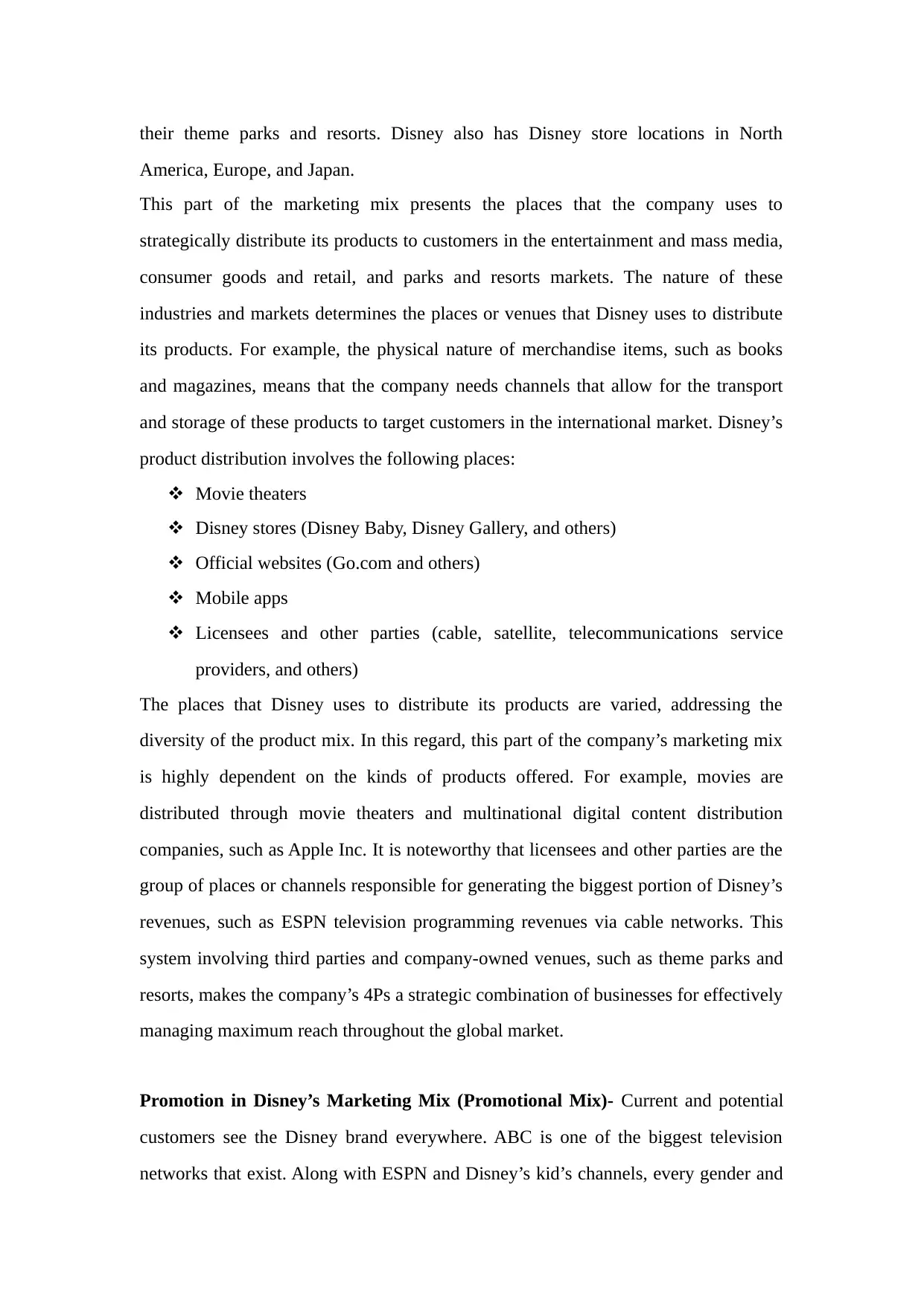
their theme parks and resorts. Disney also has Disney store locations in North
America, Europe, and Japan.
This part of the marketing mix presents the places that the company uses to
strategically distribute its products to customers in the entertainment and mass media,
consumer goods and retail, and parks and resorts markets. The nature of these
industries and markets determines the places or venues that Disney uses to distribute
its products. For example, the physical nature of merchandise items, such as books
and magazines, means that the company needs channels that allow for the transport
and storage of these products to target customers in the international market. Disney’s
product distribution involves the following places:
Movie theaters
Disney stores (Disney Baby, Disney Gallery, and others)
Official websites (Go.com and others)
Mobile apps
Licensees and other parties (cable, satellite, telecommunications service
providers, and others)
The places that Disney uses to distribute its products are varied, addressing the
diversity of the product mix. In this regard, this part of the company’s marketing mix
is highly dependent on the kinds of products offered. For example, movies are
distributed through movie theaters and multinational digital content distribution
companies, such as Apple Inc. It is noteworthy that licensees and other parties are the
group of places or channels responsible for generating the biggest portion of Disney’s
revenues, such as ESPN television programming revenues via cable networks. This
system involving third parties and company-owned venues, such as theme parks and
resorts, makes the company’s 4Ps a strategic combination of businesses for effectively
managing maximum reach throughout the global market.
Promotion in Disney’s Marketing Mix (Promotional Mix)- Current and potential
customers see the Disney brand everywhere. ABC is one of the biggest television
networks that exist. Along with ESPN and Disney’s kid’s channels, every gender and
America, Europe, and Japan.
This part of the marketing mix presents the places that the company uses to
strategically distribute its products to customers in the entertainment and mass media,
consumer goods and retail, and parks and resorts markets. The nature of these
industries and markets determines the places or venues that Disney uses to distribute
its products. For example, the physical nature of merchandise items, such as books
and magazines, means that the company needs channels that allow for the transport
and storage of these products to target customers in the international market. Disney’s
product distribution involves the following places:
Movie theaters
Disney stores (Disney Baby, Disney Gallery, and others)
Official websites (Go.com and others)
Mobile apps
Licensees and other parties (cable, satellite, telecommunications service
providers, and others)
The places that Disney uses to distribute its products are varied, addressing the
diversity of the product mix. In this regard, this part of the company’s marketing mix
is highly dependent on the kinds of products offered. For example, movies are
distributed through movie theaters and multinational digital content distribution
companies, such as Apple Inc. It is noteworthy that licensees and other parties are the
group of places or channels responsible for generating the biggest portion of Disney’s
revenues, such as ESPN television programming revenues via cable networks. This
system involving third parties and company-owned venues, such as theme parks and
resorts, makes the company’s 4Ps a strategic combination of businesses for effectively
managing maximum reach throughout the global market.
Promotion in Disney’s Marketing Mix (Promotional Mix)- Current and potential
customers see the Disney brand everywhere. ABC is one of the biggest television
networks that exist. Along with ESPN and Disney’s kid’s channels, every gender and
⊘ This is a preview!⊘
Do you want full access?
Subscribe today to unlock all pages.

Trusted by 1+ million students worldwide
1 out of 16
Related Documents
Your All-in-One AI-Powered Toolkit for Academic Success.
+13062052269
info@desklib.com
Available 24*7 on WhatsApp / Email
![[object Object]](/_next/static/media/star-bottom.7253800d.svg)
Unlock your academic potential
Copyright © 2020–2025 A2Z Services. All Rights Reserved. Developed and managed by ZUCOL.





